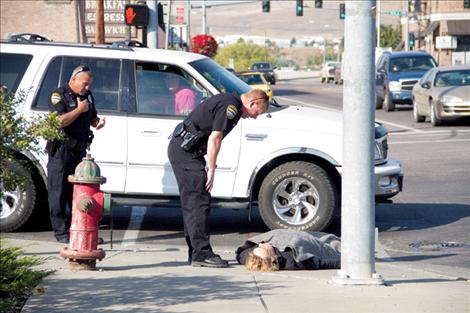A massacre of 28 children and teachers at a school in Connecticut on December 15 has received weeks of intensive media coverage. And yet very little attention is paid to the roughly 100 people killed in the U.S. every day by motor vehicles. The carnage at the scene of a serious road accident is just as horrific as a battlefield, but only those directly involved – the victims and the workers whose job is to clean up the mess – are fully aware of it as an everyday reality.
Millions of animals – deer, badgers, frogs, birds, etc. – also die on the roads. They are called “roadkill”. That seems an apt term for the human casualties too. Worldwide human roadkill is estimated at 1.3 million a year. The injured number in the tens of millions.
Average annual human roadkill in the U.S. in recent years has been about 40,000. Another couple of million are hurt; 250,000 of them have sufficiently bad injuries and sufficiently good health insurance to be hospitalized.



There has been a modest decline since the 1970s, when the yearly average was about 50,000. Various reasons have been suggested for the decline, including a crackdown on drunk driving and the adoption of certain safety features, especially seat belts and eventually (in the 1990s) air bags. We owe these improvements to persistent efforts by campaigners for safer car design, Ralph Nader being the best known.
Feeling safe
This example demonstrates that campaigns for reform can sometimes achieve worthwhile results. Worthwhile, but limited and temporary. Because there has been no decisive reorientation of car design toward safety, as opposed to style, power and comfort.
Thus, as Catherine Lutz and Anne Lutz Fernandez point out, car manufacturers prefer to make the driver feel safe rather than help him drive safely By swaddling driver and passengers in a warm, quiet and smoothly moving cocoon, insulated from the noise and bumps of the road, they “prevent drivers from sensing how fast they are going or how dangerous the road conditions are” (Carjacked: The Culture of the Automobile and its Effect on our Lives, Palgrave Macmillan 2010, p. 179).
However, the biggest setback to the cause of safe design has been the rise of the monsters known as Sport Utility Vehicles. SUVs are much more prone to roll over than ordinary cars and much more lethal when they collide with other road users (Keith Bradsher, High and Mighty: The Dangerous Rise of the SUV, PublicAffairs 2002).
The decline in human roadkill is partly the result of people minimising their exposure to traffic as pedestrians, though at a high cost in the form of isolation and loss of community. In the old days, when motor vehicles were few and far between, children were free to roam around on their own and play with friends in the streets. Now they are cooped up at home. There they can prepare for their future role as drivers by playing video games like Carmageddon, where the goal is to smash up as many other cars and run down as many pedestrians as possible.
Pollutants
Besides direct roadkill, cars harm and kill people through the pollutants that they emit into the air we breathe. Here too campaigns for reform have had some successes. In particular, exhaust filters are now in wider use and petrol no longer contains lead additives.
Here too, however, the few successes are overshadowed by a daunting list of failures. And here too SUVs are the worst culprits. Motor vehicles still emit enormous quantities of tiny particles and poisonous compounds, including nitrous oxides, carbon monoxide and volatile organic compounds that react in sunlight to form ozone. Most of these gases and particles do most harm to the respiratory system, causing such diseases as asthma, bronchitis, emphysema and lung cancer. Another pollutant, benzene, damages the bone marrow and immune system and causes leukemia and other blood cancers.
A car emits poisons into the air both inside and outside, making it hard to tell whether it is less unhealthy to ride with the windows closed or open.
Burdens on society
These are not the only burdens that the car imposes on society. It devours enormous material and labour resources and generates a vast stream of material waste, much of it hazardous and/or non-recyclable. The car and the hydrocarbon fuels that power it make a big contribution to the atmospheric concentration of greenhouse gases and thereby to climate change.
Cars have a huge impact on land use. Land is used to manufacture cars, sell cars (showrooms), service and repair cars (garages, filling stations), wash cars, drive cars (roads, driveways) and – no small item! – park cars (roadsides, car parks, home garages). An expanding area of arable land is being used to cultivate biofuels for cars.
These burdens grow heavier as the numbers of cars (and especially SUVs) increase. The total number of motor vehicles in the world passed the one-billion mark in 2010. It can be expected to continue rising rapidly as cheaper models open up new consumer markets in countries such as India and China.
In one of my favorite science fiction stories (I don't remember the author or title) an extraterrestrial observer theorizes that the dominant life form on our planet is the motor vehicle and that human beings exist solely to service them. It is a natural conclusion for an extraterrestrial to draw from landscapes like these:


Cars and socialism
So we pay a terrible price for the motor car – in pollution and disease, ugliness and noise, social atomisation, injury and death. Does it follow that a socialist community is likely to decide to stop producing cars? How compatible would such a decision be with the idea of socialism as a world of material abundance and free access?
First point. Socialism will make a lot of car travel unnecessary. This applies especially to commuting. Many jobs to which people now commute will disappear with the abolition of money. Over time geographical patterns of habitation and production can be changed to enable most people to live close enough to their work not to need a car to get there.
We can expect new forms of public transport and the restoration of environment-friendly old forms such as trams and perhaps even canal barges (for non-perishable supplies). Sizeable urban areas can be made safe as pedestrian precincts. Some towns in Germany are already car-free and accessible only by rail.
Second point. Replacing petrol-guzzling motor cars by electric cars should reduce pollution from cars and their contribution to global heating, provided that the electricity comes from low-carbon sources (not from coal, as it often does at present).
Sharing systems
Third point. Free access to car transport as a service can be achieved without permanently assigning a car to each family or individual. In social terms, the current arrangement, with most cars sitting unused most of the time, is extremely wasteful. The total number of cars required can be minimised by relying on a pool of cars available through a network of depots.
When people want to go on a trip that cannot conveniently be made by public transport, they will borrow a car from the nearest depot. When they no longer need the car, they will return it to the network (not necessarily to the same depot). The depot staff will recharge, repair and maintain the vehicles and monitor their use.
Such arrangements already exist, though not for cars. The public lending library provides free access to books and cassettes. A free-access sharing system for bicycles was pioneered in Amsterdam by the Provos in the 1960s and now exists in Paris, Hangzhou and many other cities. In socialism sharing systems will expand to cover specialised tools and other things that people need to use occasionally.
In a free-access society people will develop a different psychology. They will view the goods being held for their use in public stores and depots as already belonging to them. As they will have free access to those things whenever needed, they will feel no urge to transfer stuff to their homes in order to make it “theirs”. Such pointless behaviour will appear pathological. People will feel a need for exclusive and permanent possession only of those things which have a special personal meaning for them.
Electric cars still a problem?
So it may be possible to provide free access to electric cars at a social cost lower than that now paid for motor cars. Much lower, perhaps, but still considerable. Switching to electric cars would not prevent road accidents. Electric cars also pose environmental problems of their own.
There are two types of electric car: one runs on a battery, the other is powered by a stack of hydrogen fuel cells. However, the manufacture of both devices depends on the availability of rare earth metals (REMs). These substances occur in very low-concentration ores from which they have to be separated out by means of acid baths and other processes, generating vast quantities of highly toxic waste.
The REM smelting plants in Inner Mongolia dump the waste into a large pool. From there the ‘radioactive sludge’ seeps into the soil and groundwater, destroying local agriculture and the health of local residents. A socialist society could not tolerate such poisoning of the environment, even in a single locality. No local community would voluntarily sacrifice itself to provide the world with certain raw materials. And the world administration would lack the coercive power to sacrifice a local community against its will.
So the waste would have to be reprocessed, stored in sealed vessels and buried in stable geological structures deep underground. This is not done under capitalism because it would cost too much. But even in socialism it will surely be impracticable to store more than a certain quantity of waste in this way, especially as it will be in addition to hundreds of thousands of tons of accumulated nuclear waste in urgent need of similar treatment.
That constraint will limit the amount of REMs extracted. And as REMs will be needed for many other uses (including energy-efficient fluorescent lamps and magnets for wind turbines) it will be necessary to set priorities for their allocation.
Free access to everything?
Thus, we cannot be sure whether socialist society will be able or willing to provide free access to car transport. The social cost associated with maintaining an adequate pool of electric cars may still be judged unacceptably high.
It’s doubtful that there could ever be free access to everything – to space travel, for instance. The world socialist community will have to decide, through its democratic institutions and procedures, what free access will and will not cover, and how to distribute things to which free access cannot be provided.
STEFAN
Socialist Standard, February and March 2013 or personal site
